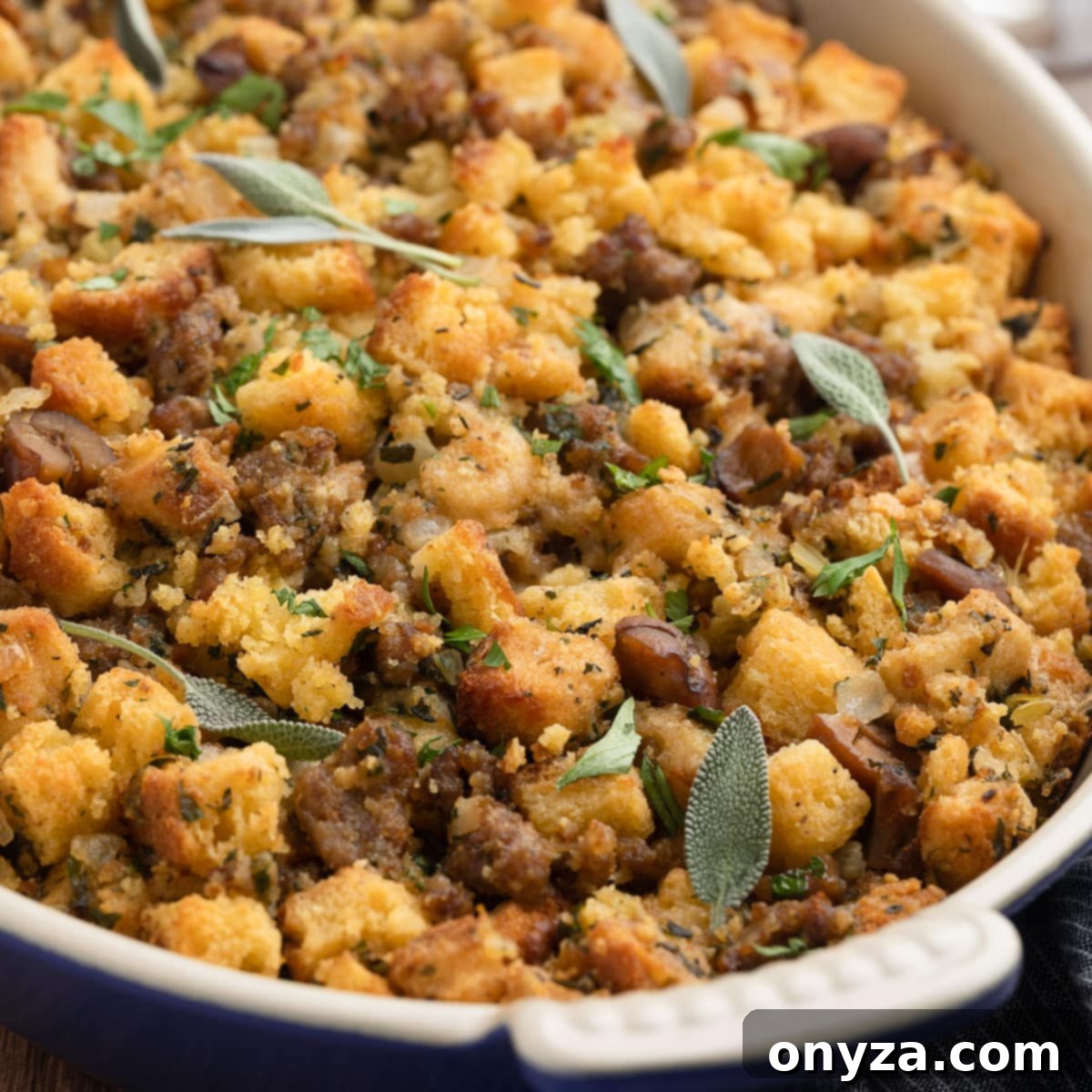Elevate your holiday feast with this sensational Sausage and Chestnut Stuffing, a centerpiece dish that masterfully blends the rustic charm of cornbread with the classic appeal of country white bread. Infused with rich, savory Italian sausage, tender, buttery chestnuts, a subtle hint of sweet apple cider, and an aromatic bouquet of fresh herbs, this stuffing is designed to complement your roasted turkey perfectly. More than just a side, it’s a celebration of textures and flavors, offering a hearty and deeply satisfying addition to any festive table. Best of all, thoughtful partial preparation ahead of time ensures a smooth and stress-free cooking experience, letting you savor every moment of your holiday gathering.

Mastering Your Holiday Stuffing: Essential Tips Before You Begin
While this beloved recipe is titled “Sausage and Chestnut Stuffing,” it’s worth noting the technical distinction: since it’s baked independently in a pan rather than inside the bird, it’s technically a “dressing.” However, in many households, especially my Northeast-based family, the term “stuffing” is used interchangeably, regardless of the cooking method. This particular recipe offers a more robust and satisfying texture compared to many Southern cornbread dressings, thanks to its use of cubed, toasted bread rather than a softer, crumbled base.
To achieve the best results, advance planning is key. You’ll need to have day-old cornbread readily available, whether you opt for a quality store-bought version or prefer to bake your own. If you choose to use a homemade recipe, such as my Buttermilk Skillet Cornbread, remember to reduce the sugar content to just 2-3 tablespoons. This adjustment is crucial for ensuring a less sweet, more savory foundation that perfectly complements the rich flavors of the sausage and chestnuts.
Craving more innovative or classic holiday stuffing ideas? Explore my other delightful recipes: the timeless Traditional Bread Stuffing with Herbs, or the vibrant and fruity Cranberry Pecan Stuffing, each offering a unique twist to your festive table.
Crafting the Perfect Sausage and Chestnut Stuffing: A Step-by-Step Guide
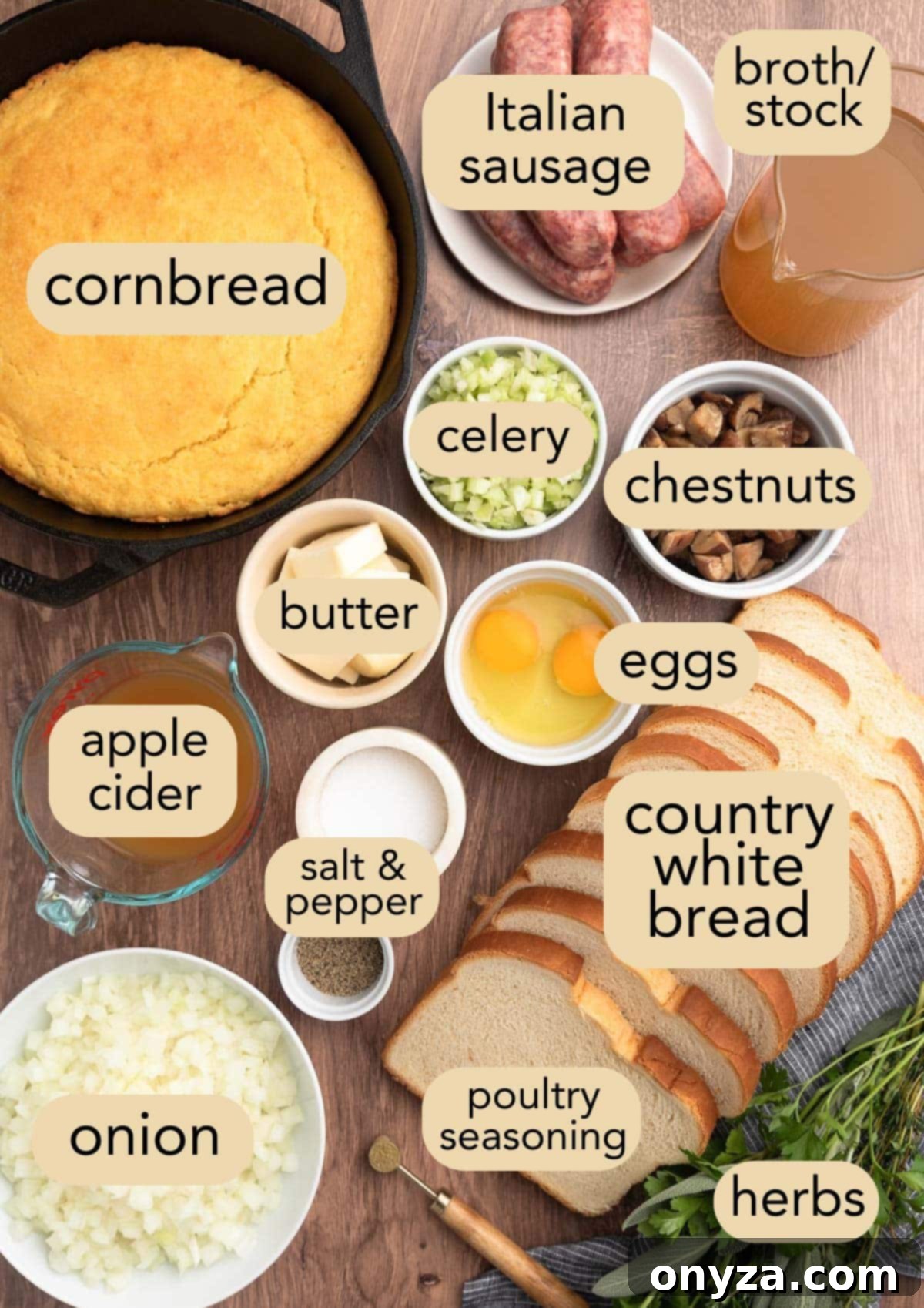
Step 1: Preparing Your Foundation – The Perfect Croutons
The secret to a great stuffing lies in its foundation: well-prepared bread cubes. Begin by cutting your day-old cornbread and country white bread into uniform 1/2- to 3/4-inch cubes. This precise sizing ensures even drying and optimal absorption. Drying the bread in the oven is a critical step; it prevents the stuffing from becoming mushy by allowing the bread to properly soak up the butter, apple cider, eggs, and stock without falling apart.
For the white bread component, I highly recommend using softer sandwich breads like Arnold Country White (as pictured) or Pepperidge Farm Farmhouse White. With these varieties, you can conveniently leave the crusts on. However, if you opt for a crustier white bread, be sure to trim away any hard edges to maintain a consistent texture throughout your stuffing.
You’ll need a total of 6 cups of cornbread cubes, which typically amounts to approximately 1 pound. For the white bread, gather 6 cups of cubes, which usually translates to about 6-7 slices or roughly 2/3 pound when using brands like Arnold Country White. Consistency in both cube size and measurement is key for this recipe.
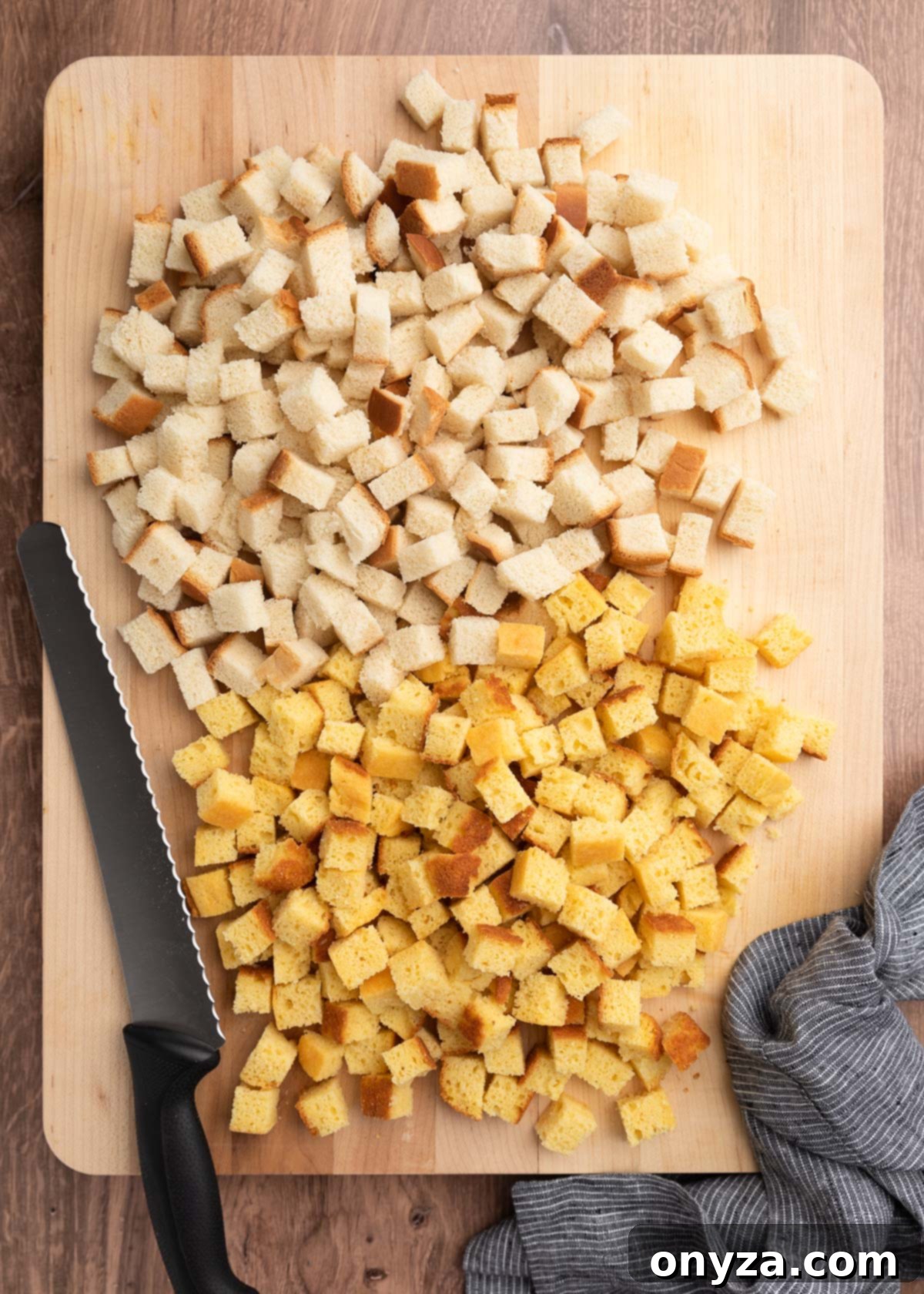
Once cubed, spread the bread pieces evenly across two rimmed baking sheets. Bake them in an oven preheated to 250°F for 50-65 minutes, or until they are thoroughly dry and lightly toasted. To ensure uniform drying, remember to rotate the pans halfway through the baking process and gently stir the bread cubes. You’ll likely notice that the white bread cubes tend to firm up a bit quicker, usually around 50-55 minutes, while the cornbread might require a slightly longer baking time, closer to 60-65 minutes. After baking, it’s essential to let the croutons cool completely before proceeding to assemble the stuffing, as this prevents premature softening.
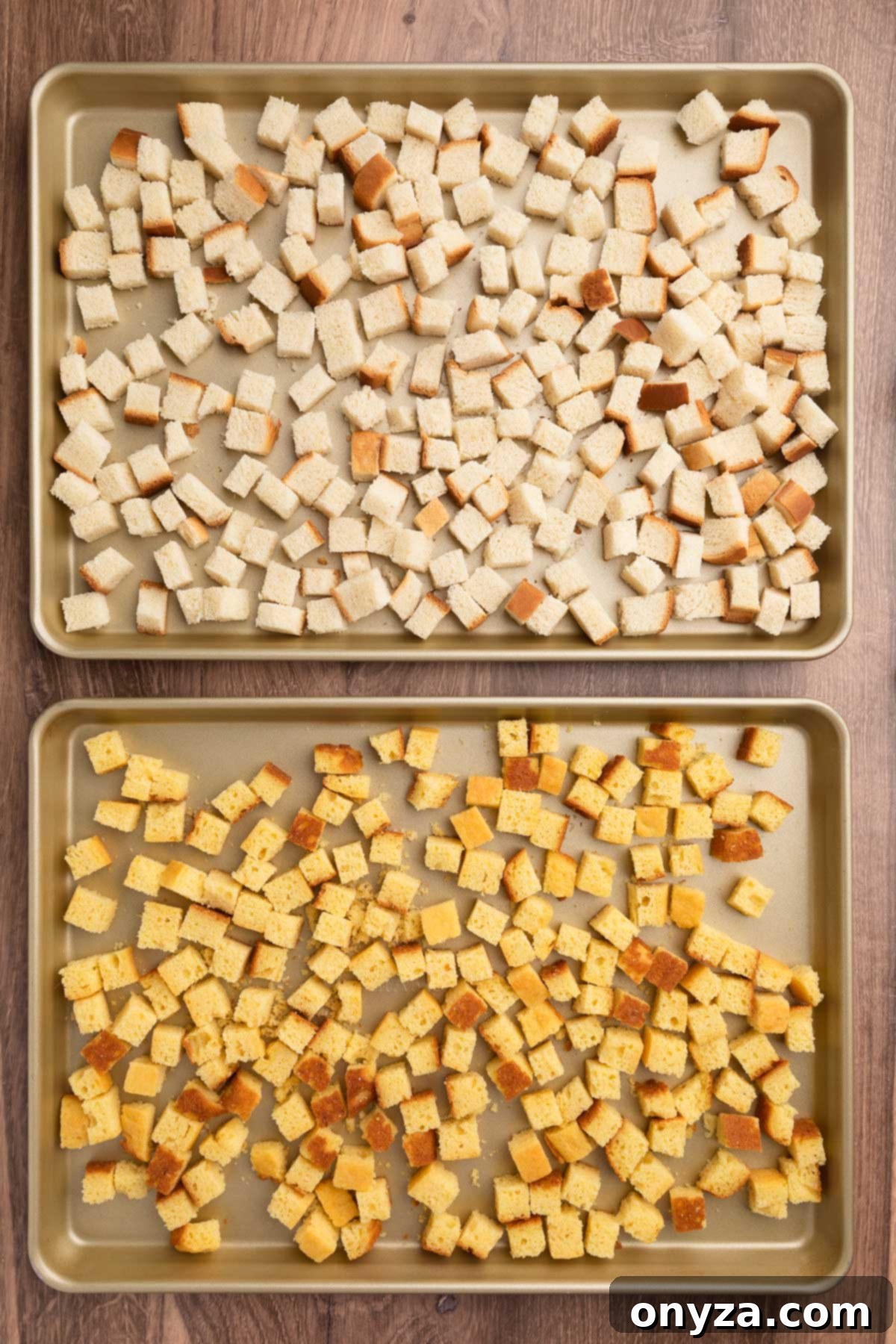
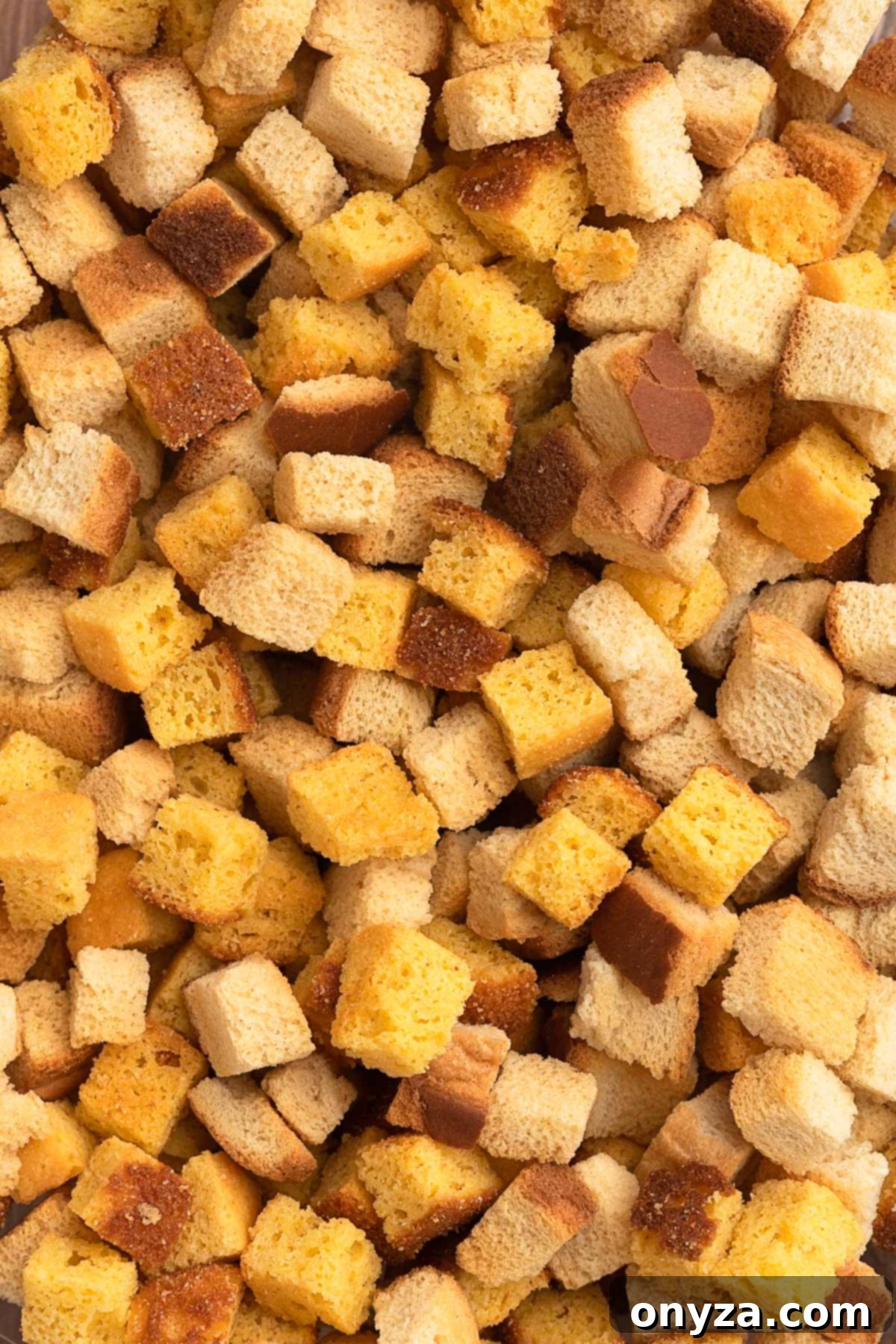
Step 2: Building Flavor – Sautéing Sausage and Aromatics
Next, it’s time to build the robust flavor base for your stuffing. In a large 12-inch skillet (my preferred size for ample cooking space), melt 2 tablespoons of unsalted butter over medium-high heat. Add 1 pound of loose sweet Italian sausage. If you’ve purchased link-style sausage, simply remove the casings by making a shallow slit along the length of each raw sausage with a paring knife and peeling them away. This ensures the meat can crumble effectively.
Break up the sausage into bite-sized crumbles using a wooden spoon or spatula, and cook until it is beautifully browned and thoroughly cooked through. Once done, use a slotted spoon to transfer the browned sausage crumbles to a large mixing bowl, ensuring you leave the flavorful rendered fat behind in the skillet. This rendered fat is crucial for the next step, as it will infuse your vegetables with rich, savory notes.
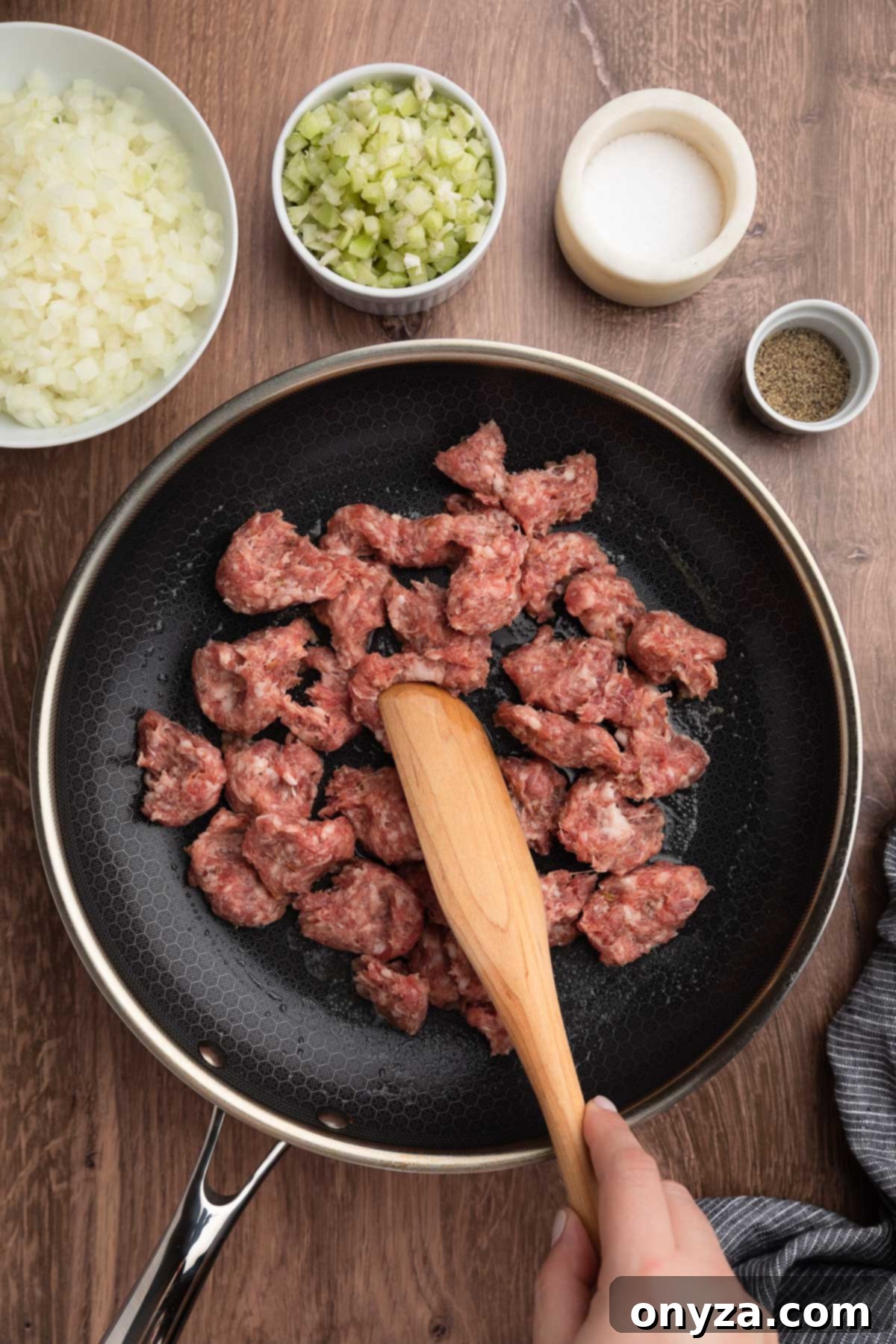
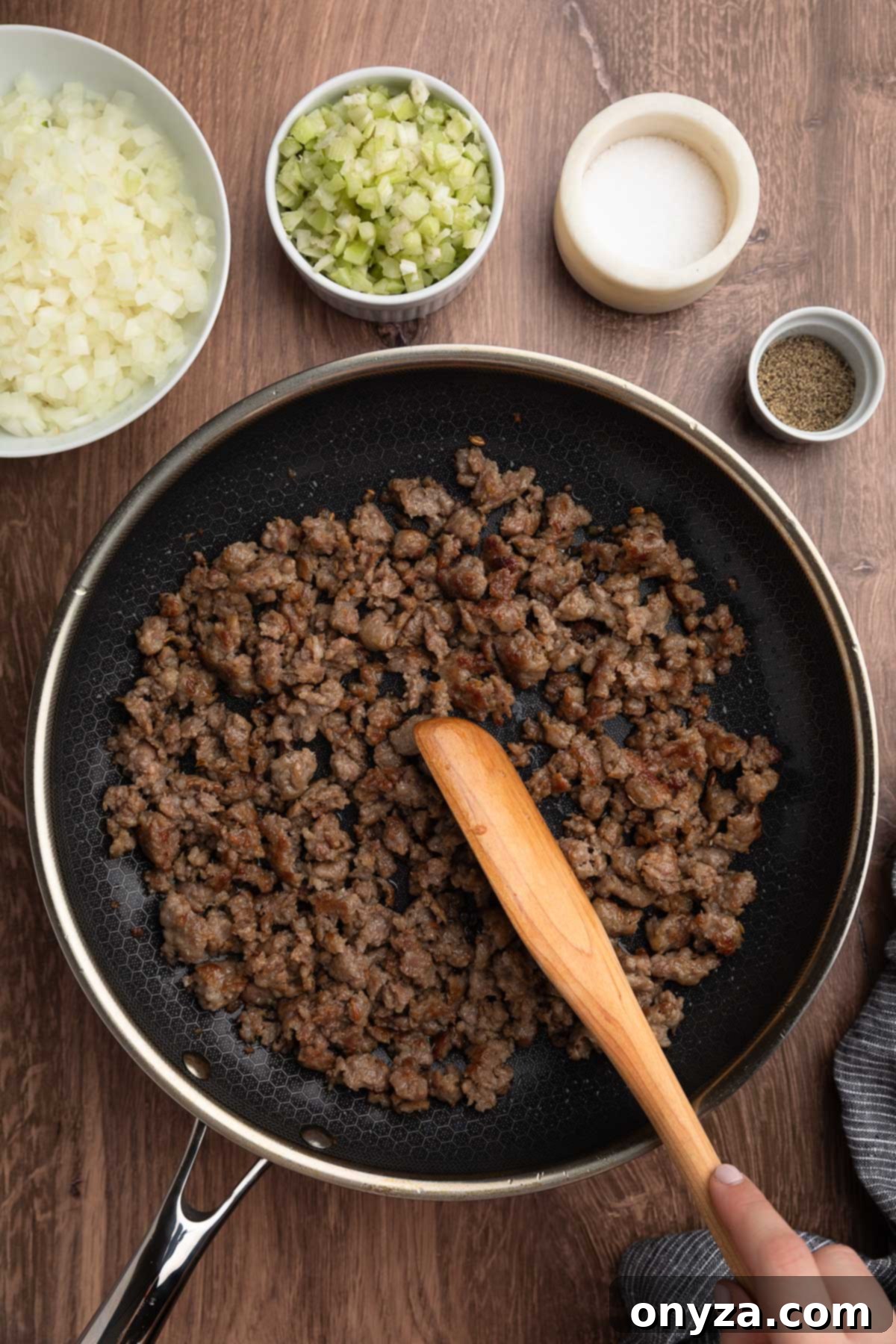
To the skillet containing the rendered sausage fat, add 4 more tablespoons of unsalted butter and reduce the heat to medium. Once the butter is melted, add the precisely diced celery and onions (ensuring they are uniformly cut into 1/4-inch pieces) and cook for about 8-10 minutes, stirring frequently. The goal here is to soften the vegetables until they become translucent and tender, releasing their sweet aromas and flavors, without allowing them to brown. This gentle sautéing ensures they integrate seamlessly into the stuffing’s texture.
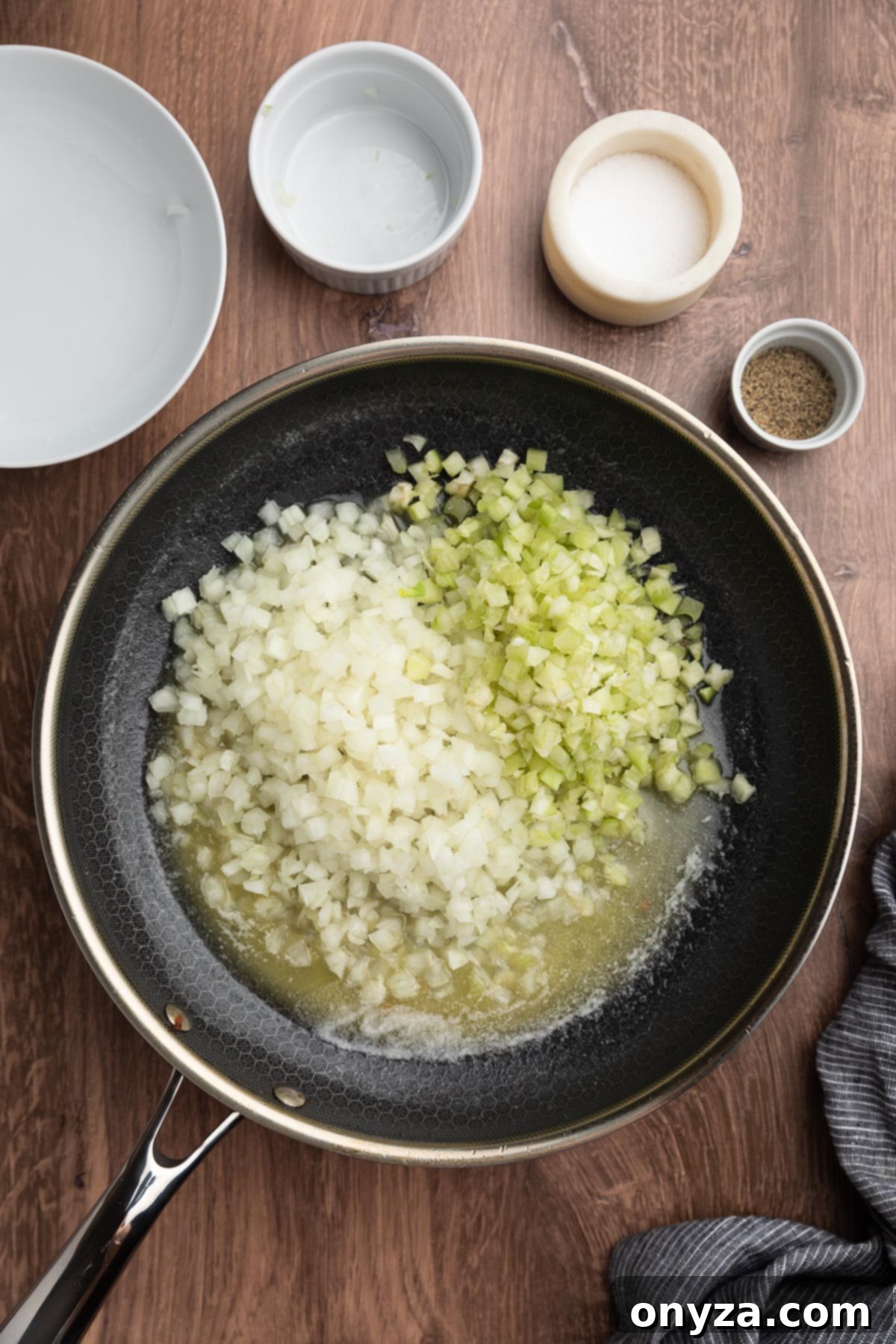
Now, it’s time to infuse the vegetables with aromatic seasonings. Stir the following into the softened celery and onions:
- Finely Chopped Fresh Herbs. Our family favorite is a harmonious blend of 2 tablespoons of sage, 2 teaspoons of thyme, and 1 teaspoon of rosemary. However, feel free to adjust these proportions to perfectly match your personal taste preferences, ensuring the total amount remains around 3 tablespoons for optimal flavor balance.
- Poultry Seasoning. A subtle addition of Bell’s All Natural Seasoning, a classic blend of dried and ground rosemary, oregano, sage, ginger, marjoram, thyme, and pepper, significantly enhances the stuffing’s depth and traditional holiday character.
- Kosher Salt and Freshly Ground Black Pepper. Begin with 1 teaspoon of Diamond Crystal kosher salt and 1/2 teaspoon of freshly ground black pepper. This initial seasoning can be further adjusted to perfection later in the assembly stage, allowing you full control over the final flavor profile.
Continue to cook this fragrant mixture for about 1 minute, just until the herbs become wonderfully aromatic, releasing their essential oils into the vegetables. Then, promptly remove the vegetable mixture from the heat, preserving its fresh, vibrant flavors.
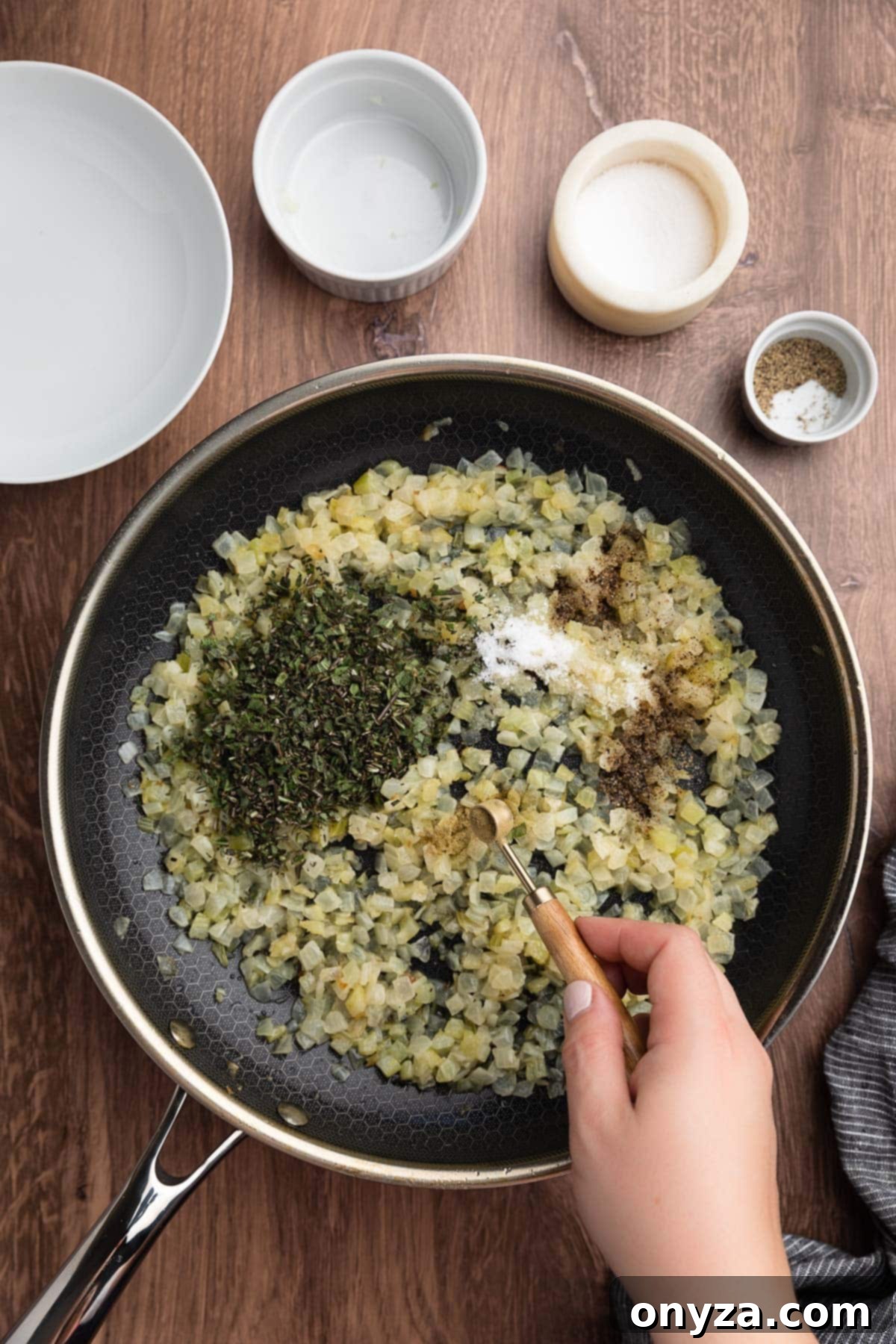
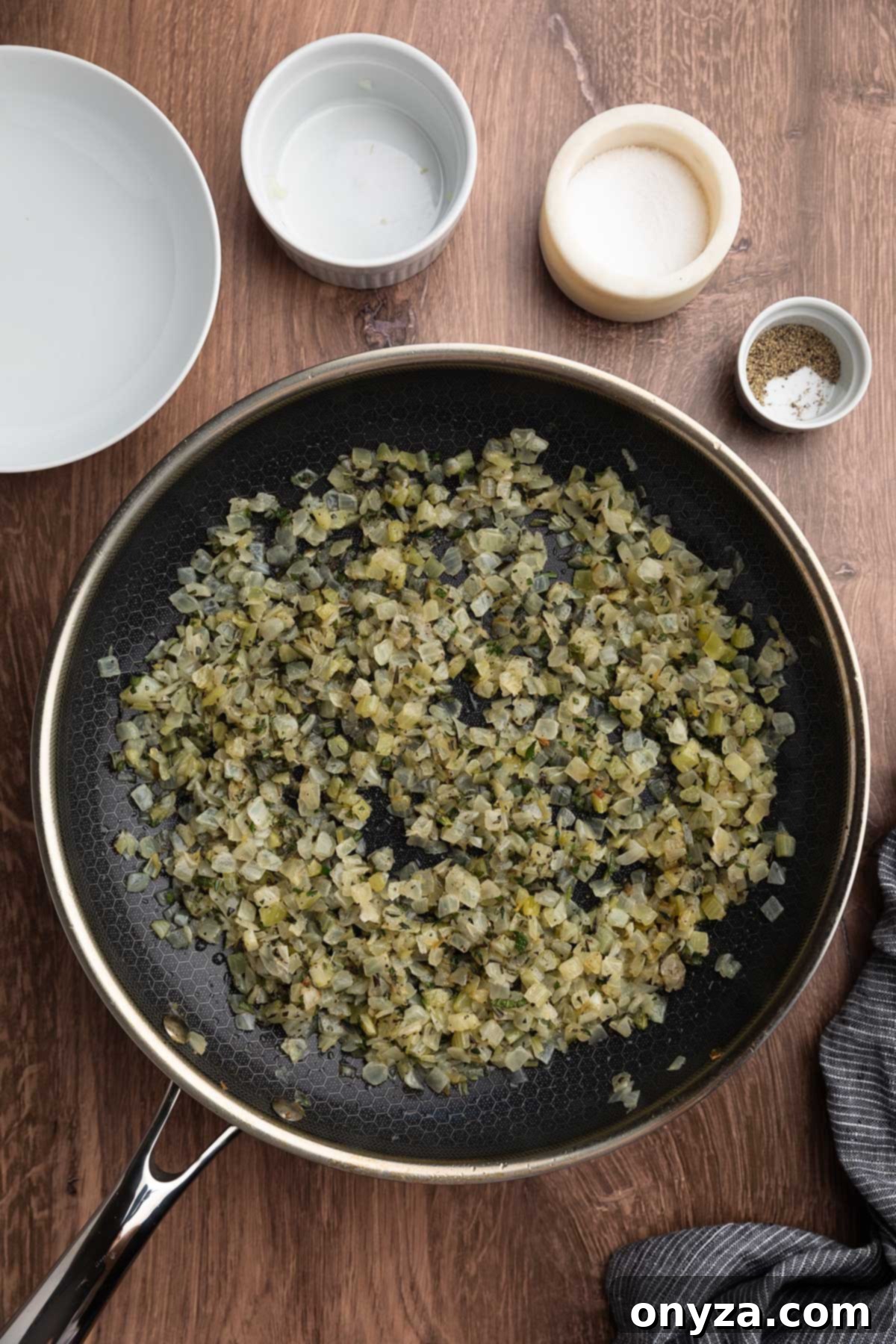
Step 3: Bringing it All Together – Assembling Your Stuffing
With all your components ready, it’s time to assemble the stuffing. In a generously sized mixing bowl, ideally with at least a 4-1/2 quart capacity to allow for easy stirring, gently combine the cooled croutons, the browned sausage crumbles, the sautéed vegetables and herbs, the quartered roasted or steamed chestnuts, and a vibrant sprinkle of chopped flat-leaf parsley. Mix these ingredients carefully to ensure an even distribution without crushing the bread cubes.
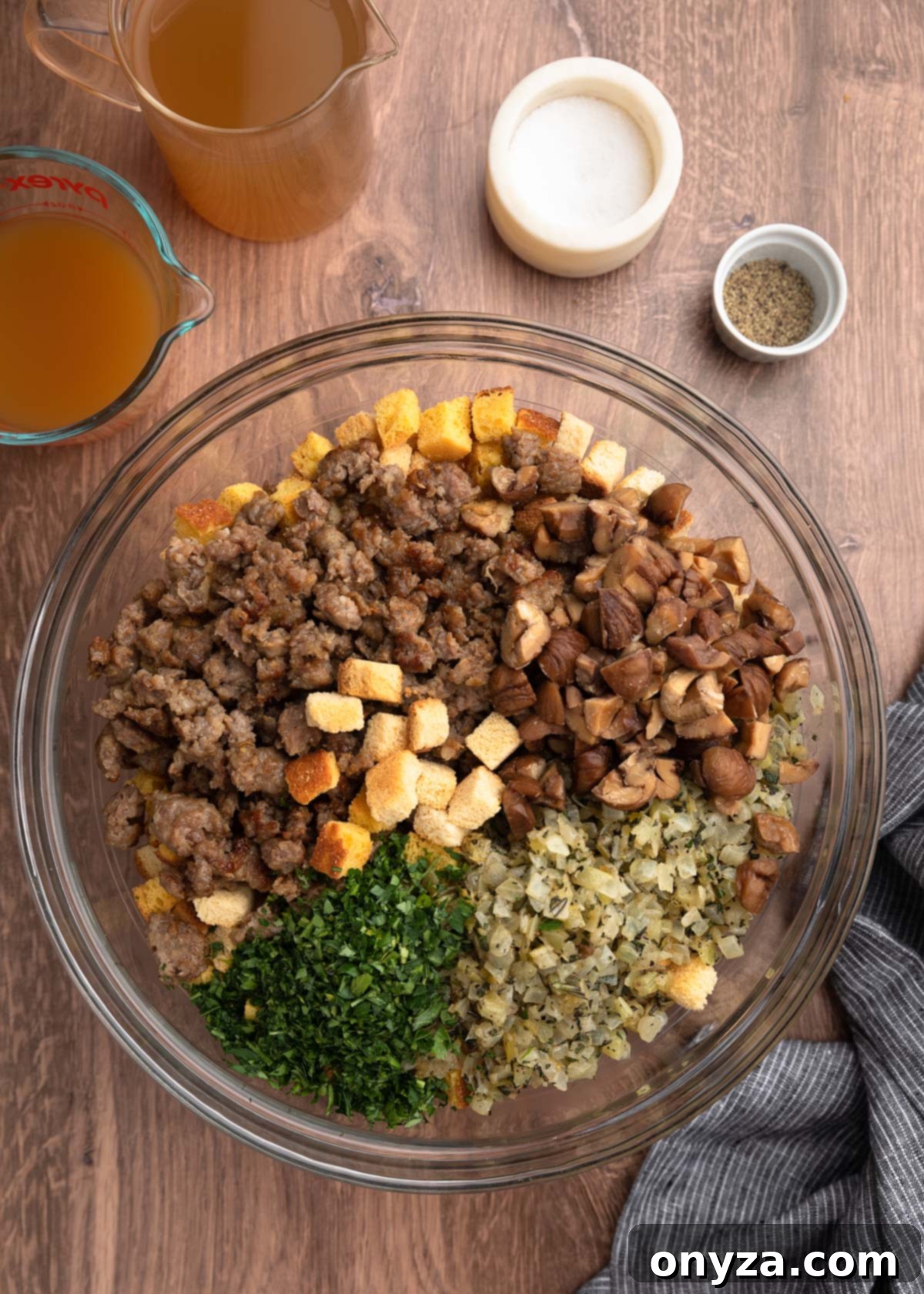
Next, pour in 1 cup of sweet apple cider and 1 cup of low-sodium chicken or turkey broth. Gently toss the mixture again to combine, then allow it to rest for a few minutes. This crucial resting period gives the dried bread cubes ample time to absorb the liquids, softening them and infusing them with flavor. The apple cider adds a delightful subtle sweetness and tang that brightens the rich sausage and chestnuts.
Ingredient Tip: For an unparalleled depth of flavor and complete control over salinity, I highly recommend using my Make-Ahead Turkey Stock in this stuffing recipe. Its salt-free nature allows you to perfectly season the dish to your preference, while imparting a rich, authentic turkey flavor. If using store-bought broth or stock, always opt for the lowest sodium option available; I’ve consistently achieved excellent results with Pacific Foods’ Organic Low Sodium Chicken Broth, which contains only 50 mg of sodium per cup, ensuring your stuffing isn’t overly salty.
Before adding the eggs, now is your final opportunity to taste the mixture and adjust the seasonings. Add more salt, pepper, or poultry seasoning if needed. I typically find myself adding an additional 1/2 to 1 teaspoon of salt and another 1/2 teaspoon of pepper to achieve the desired balance. This is the last chance to taste and adjust the flavors, so ensure you are completely satisfied before proceeding.
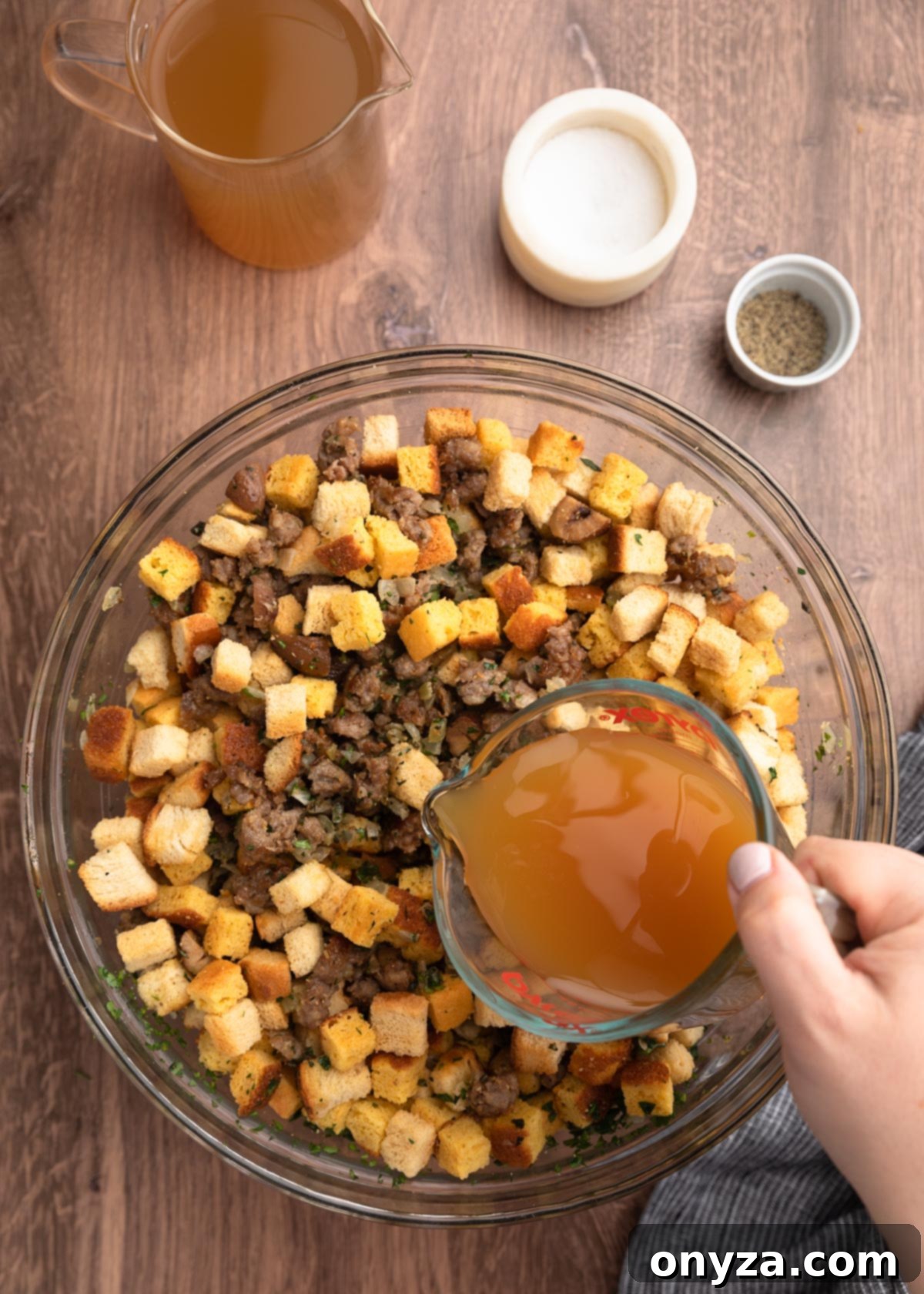
In a separate measuring cup, whisk together 2 large eggs with an additional 1/2 cup of broth. Pour this egg and broth mixture over the stuffing ingredients in the large bowl. Gently mix everything together once more, and then allow it to rest for another couple of minutes to ensure all the liquid is thoroughly soaked up. Don’t worry if some of the cornbread cubes begin to break up slightly; this is a normal part of the process and contributes to the stuffing’s rustic texture.
Finally, check the moisture level of your stuffing. Pick up a white bread crouton and give it a gentle squeeze between your fingertips. It should feel consistently moist throughout, but importantly, it should not be mushy. The amount of additional liquid required can vary depending on the specific type of bread used and how thoroughly the croutons were dried in the oven. If the mixture feels too dry, add more broth, 1/4 cup at a time, gently mixing and retesting until you achieve that perfect, moist-but-not-soggy consistency. Once the texture is just right, your stuffing is ready for baking.

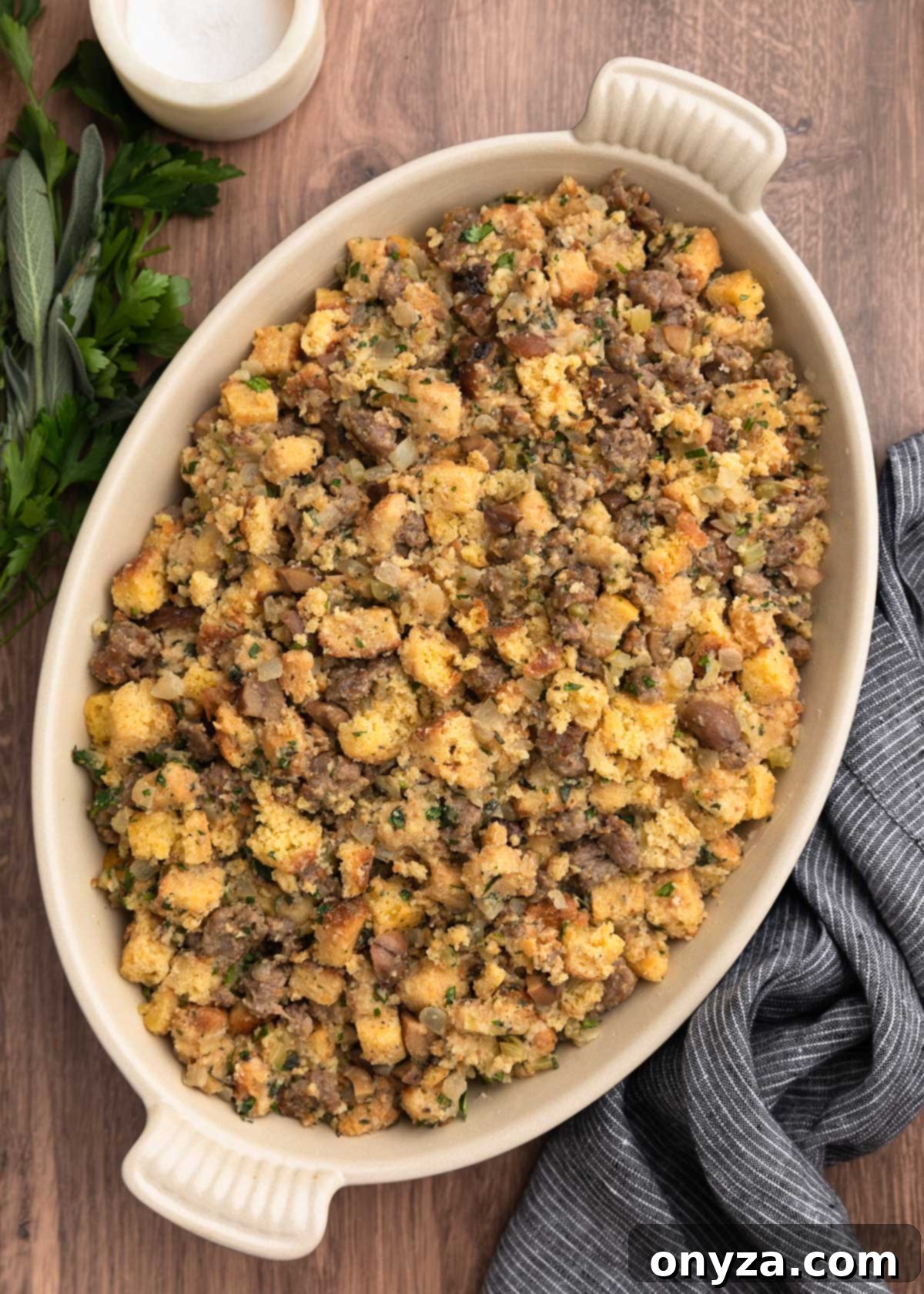
Step 4: The Grand Finale – Baking Your Stuffing to Perfection
With your beautifully assembled stuffing, it’s time for the oven. Spoon the mixture evenly into a buttered 3-quart gratin dish or a standard 13×9-inch baking dish. For an extra touch of richness and to ensure a moist, flavorful finish – after all, this is a holiday indulgence! – cut the remaining 2 tablespoons of butter into small pieces and scatter them generously across the top of the stuffing.
Cover the baking dish tightly with foil and bake at 375°F for an initial 30 minutes. This covered baking period allows the stuffing to heat through evenly and absorb the last vestiges of liquid, creating a tender interior. After 30 minutes, remove the foil and continue baking for another 15-20 minutes. During this uncovered phase, the stuffing will develop a beautiful, lightly golden-brown crust with irresistibly crispy edges. Ensure the stuffing is heated thoroughly by checking that its center reaches at least 165°F with a food thermometer.
Once baked to perfection, allow the stuffing to rest for about 10 minutes after removing it from the oven. This brief resting period helps the flavors meld and the texture set beautifully. Just before serving, a final flourish of chopped fresh parsley and a few small, vibrant sage leaves sprinkled over the top will add a fresh aroma and an elegant, picture-perfect finish.
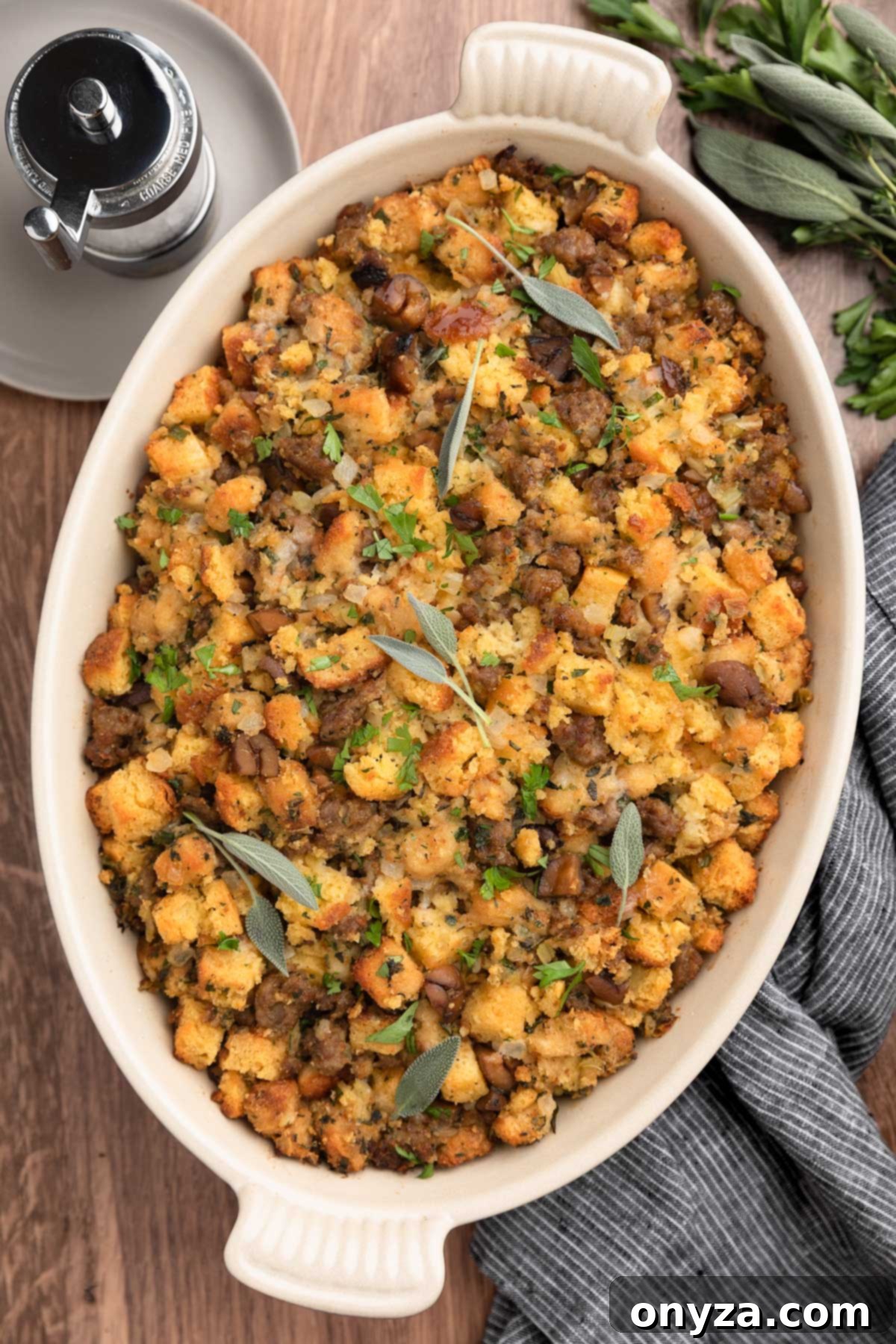
Smart Prep-Ahead Strategies for a Stress-Free Holiday
One of the greatest advantages of this Sausage and Chestnut Stuffing recipe is the flexibility it offers for holiday meal planning. Several key components can be prepared in advance, significantly reducing your “to-do” list on the busiest cooking days, especially when your attention is focused on roasting the turkey or other main dishes.
- Vegetables. To save precious time on the big day, chop your onions and celery a day or two ahead of time. Store them securely in airtight containers or zip-top bags in the refrigerator, ready to be sautéed.
- Herbs. For the freshest and most vibrant flavor, it’s best to chop your fresh herbs the morning of the day you plan to assemble and bake the stuffing. Once chopped, cover them lightly and refrigerate until you are ready to incorporate them into the recipe.
- Chestnuts. Utilizing high-quality imported jarred steamed or roasted chestnuts (such as those from Clement Faugier or La Forestiere) is a fantastic time-saver, and they deliver delicious results. Quarter these chestnuts the day before and keep them tightly covered in the refrigerator.
- Croutons. The essential bread croutons can be prepared up to 3 days in advance. After they have completely cooled from the oven, transfer them to airtight containers or zip-top bags and store them at room temperature. This ensures they remain perfectly dry and crisp for optimal liquid absorption.
For adherence to Stuffing Food Safety guidelines, the USDA advises against assembling and refrigerating unbaked stuffing, as it can create an environment conducive to bacterial growth. To ensure safety and peak quality, follow these prep-ahead tips and always assemble the stuffing mixture just before you intend to bake it.
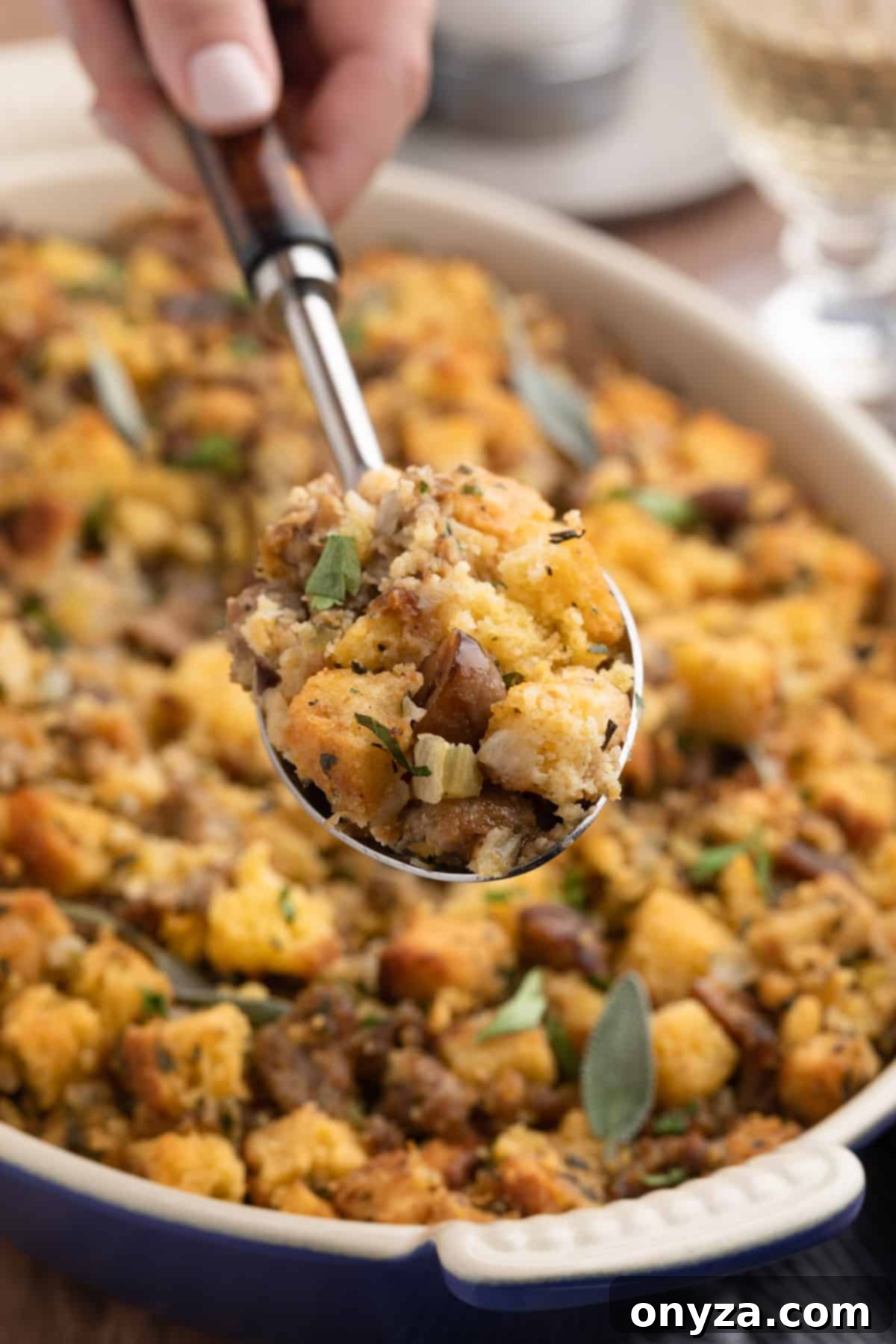
Perfect Pairings: Serving Your Savory Sausage and Chestnut Stuffing
This magnificent Sausage and Chestnut Stuffing offers a delightful and sophisticated twist on traditional holiday fare, making it an ideal companion for a succulent roasted turkey or a perfectly prepared roasted chicken. To complete your festive Thanksgiving dinner menu, consider pairing it with some of our favorite complementary side dishes:
- Cranberry Sauce. The vibrant, sweet-tart essence of cranberry sauce provides a refreshing counterpoint to the rich, savory stuffing. Explore unique variations like my Brandied Cherry Cranberry Sauce, the bright Apple Orange Cranberry Sauce, or the sophisticated Mulled Wine Cranberry Sauce for an elevated experience.
- Sweet Potatoes. A quintessential Thanksgiving staple, sweet potatoes can be enjoyed in many forms. Whether it’s a creamy, comforting Buttermilk Sweet Potato Casserole or simply whipped to perfection with brown butter, their sweetness beautifully balances the stuffing.
- Potatoes. No Thanksgiving plate is complete without a generous scoop of mashed potatoes alongside the stuffing. Our extra creamy Cream Cheese Mashed Potatoes are a long-standing family favorite. For an elegant presentation, consider Parmesan Duchess Potatoes.
- Green Beans. Choose a classic, creamy Green Bean Casserole for a truly comforting side, or opt for a lighter, more vibrant option like Lemon-Herb Brown Butter Haricots Verts, which add a fresh, crisp texture.
- Brussels Sprouts. Roasted or air-fried, Brussels sprouts achieve irresistibly crispy edges and a delightful caramelized flavor. My Roasted Brussels Sprouts with Pomegranate Glaze offer a fantastic sweet and tangy bite that complements the savory stuffing.
- Gravy. While this stuffing is wonderfully moist and flavorful on its own, a drizzle of rich homemade turkey or chicken gravy takes any bread stuffing to an entirely new level. For gravy enthusiasts (myself included!), it truly provides the perfect finishing touch, marrying all the flavors together seamlessly.
Keeping Your Stuffing Warm: If your guests aren’t quite ready to dine immediately after baking, you can easily keep the Sausage and Chestnut Stuffing warm. Transfer the covered pan to a low-temperature oven, between 200-250°F, or utilize a chafing dish. For the best texture and to maintain food safety, avoid holding it for more than 30-45 minutes, ensuring the internal temperature remains above 140°F. Should the stuffing start to appear a little dry, a gentle drizzle of warm stock over the top will wonderfully revive its moisture and flavor.

Sausage and Chestnut Stuffing
Ingredients
- 6 cups cubed day-old cornbread , 1/2- to 3/4-inch cubes, about 1 pound (see note)
- 6 cups cubed country white bread , 1/2- to 3/4-inch cubes, about 2/3 pound (see note)
- 1 pound sweet Italian sausage , casings removed
- 8 tablespoons unsalted butter , divided
- 1 cup diced celery (1/4-inch dice)
- 1-1/2 cups diced yellow onion (1/4-inch dice)
- 2 tablespoons chopped fresh sage (see note)
- 2 teaspoons chopped fresh thyme (see note)
- 1 teaspoon chopped fresh rosemary (see note)
- ¼ teaspoon poultry seasoning (I use Bell’s Seasoning)
- ¼ cup chopped flat-leaf (Italian) parsley
- 1 cup peeled roasted or steamed chestnuts , quartered (see note)
- 1 cup sweet apple cider
- 2 to 2-1/2 cups low sodium chicken or turkey stock , additional, if needed (see note)
- 2 large eggs , lightly beaten
- Diamond Crystal kosher salt and freshly ground black pepper (see note)
Instructions
- Preheat your oven to 250°F (120°C). Arrange the bread cubes in a single, even layer across two rimmed half-sheet pans. Bake for approximately 50-65 minutes, or until the bread is lightly toasted and thoroughly dried. For even drying, rotate the pans and gently stir the bread cubes halfway through the baking process. Once baked, set the croutons aside to cool completely.
- Increase the oven temperature to 375°F (190°C). Lightly butter a 3-quart gratin dish or a 13×9-inch baking dish and set it aside.
- In a 12-inch skillet, melt 2 tablespoons of butter over medium-high heat. Add the sweet Italian sausage, breaking up the meat into crumbles with a wooden spoon or spatula, and cook until it is fully browned and cooked through. Using a slotted spoon, remove the cooked sausage from the pan and transfer it to a large mixing bowl, leaving any rendered fat in the skillet.
- Add an additional 4 tablespoons of butter to the skillet with the sausage fat. Once melted, add the chopped celery and onions (1/4-inch dice) and cook over medium heat for 8-10 minutes, stirring frequently, until the onions become translucent and the celery is tender. Do not allow them to brown.
- Stir in the chopped fresh sage, rosemary, thyme, poultry seasoning, 1 teaspoon of kosher salt, and 1/2 teaspoon of freshly ground black pepper. Cook for an additional minute, allowing the herbs to become fragrant, then remove the skillet from the heat.
- In the large mixing bowl, combine the cooled bread cubes, browned sausage, the sautéed celery and onion mixture, chopped parsley, and quartered chestnuts. Gently stir all ingredients together until well combined.
- Pour the apple cider and 1 cup of broth or stock over the bread mixture. Stir to combine and then let stand for a couple of minutes, allowing the bread to absorb the liquid thoroughly. Taste the stuffing mixture and adjust seasonings with additional salt and pepper as desired. This is your last chance to season before adding raw eggs.
- In a liquid measuring cup, lightly beat the 2 large eggs together with another 1/2 cup of broth or stock. Pour this mixture over the stuffing and gently fold to combine. Again, let the stuffing stand for a few minutes to allow the bread cubes to fully soak up the added liquid.
- To check the moisture level, squeeze one of the white bread cubes between your fingertips. It should feel moistened throughout but not mushy. (White bread cubes are sturdier for this test; cornbread cubes will naturally start to break down as they absorb liquid.) If the mixture seems too dry, gently fold in additional stock, 1/4 cup at a time, retesting the moisture level after each addition until the ideal consistency is reached.
- Transfer the prepared stuffing mixture into the buttered baking pan. Cut the remaining 2 tablespoons of butter into small pieces and dot them evenly over the top of the stuffing.
- Cover the dish with foil and bake for 30 minutes. Then, remove the foil and continue baking for an additional 15-20 minutes, or until the stuffing reaches an internal temperature of 165°F (74°C) in the center and the top is lightly golden brown with crispy edges.
- Allow the stuffing to rest for 10 minutes before garnishing with fresh herbs and serving.
To make single-serving “Stuffing Muffins”
- For individual portions, generously butter standard muffin tins (you will need approximately 15 wells), ensuring the bottoms, sides, and top rims are well coated. Use an ice cream scoop to mound the stuffing mixture into each well, pressing gently to compact it. Bake uncovered at 375°F (190°C) for 20-25 minutes, until the centers reach 165°F (74°C) and the stuffing muffins are crisp and golden on top. Remove from the oven and carefully run a butter knife around the sides of each cup to loosen them. Let stand for 5 minutes, then use a fork to gently ease the muffins out of the wells and onto a serving platter.
Notes
White Bread: For the white bread component, I find that Arnold Country White or Pepperidge Farm Farmhouse White sandwich bread yields excellent results. You will need approximately 6-7 slices to yield 6 cups of cubed bread. The soft crusts can be left on for convenience.
Chestnuts: While the process of roasting fresh chestnuts at home can be rewarding, for the sake of convenience and consistent quality when incorporating them into recipes like stuffing, I almost always opt for high-quality imported jarred chestnuts. Brands such as Clement Faugier or La Forestiere are excellent choices. I typically purchase Clement Faugier at Williams-Sonoma, and La Forestiere can often be found at Whole Foods Market.
Fresh Herbs: The proportions of sage, thyme, and rosemary in this recipe can be adjusted to suit your personal taste preferences, as long as the total combined amount of herbs remains around 3 tablespoons. For instance, if you prefer a milder sage flavor in your holiday stuffing, you might decrease the sage to 1 tablespoon and increase the quantities of rosemary and thyme accordingly to maintain the overall herbal intensity.
Stock: The exact amount of stock required for this recipe can fluctuate based on several factors, including the specific bread you choose and how thoroughly the cubes have been dried in the oven. This can vary from batch to batch. For optimal flavor and sodium control, I highly recommend using my Make-Ahead Turkey Stock, which is unsalted. Alternatively, opt for a low-sodium broth, such as Pacific Foods Organic Low Sodium Chicken Broth, which contains only 50 mg of sodium per cup. If you are using a saltier store-bought broth or stock, be sure to reduce the amount of additional salt specified in the recipe.
Salt and Pepper: The final amount of salt and pepper needed to perfectly season this recipe is not only a matter of personal taste but also depends on the inherent saltiness of your chosen stock and the spice level of your Italian sausage. For food safety reasons, it is crucial to complete all seasoning adjustments before adding the raw eggs to the mixture and to avoid re-tasting the stuffing until it is fully cooked.
Baking Tip: As every oven can vary in performance, it’s advisable to closely monitor your stuffing after it’s uncovered during baking. This vigilance ensures it doesn’t become overly dry or develop an excessively crisp crust. If you notice the stuffing starting to look dry, simply pour a few additional tablespoons of reserved stock over the top to gently moisten it and maintain its perfect texture.
Nutrition Estimate
Nutrition information is automatically calculated, so should only be used as an approximation.
Please note that our recipes have been developed using the US Customary measurement system and have not been tested for high altitude/elevation cooking and baking.
